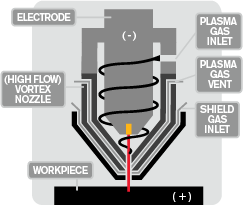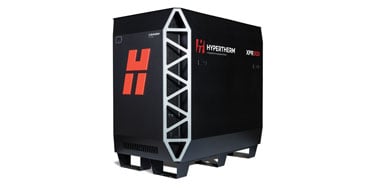Conventional single flow plasma
 This process generally uses a single gas (usually air or nitrogen) that both produces and cools the plasma.
This process generally uses a single gas (usually air or nitrogen) that both produces and cools the plasma.
Dual flow plasma (unshielded)
This process utilizes two gases; one for the plasma and one as a shield gas. In smaller systems (under 125 amps), compressed air is often used as both the plasma and shield gases. Dual gas unshielded systems have an exposed nozzle and should not be used for drag cutting.
Dual flow plasma (shielded)
 This process uses two gases, a plasma gas and a shield gas. In systems under 125 amps, air is often used as both plasma and shield. The advantage of the shield technology is that it electrically insulates the nozzle from contact with molten metal blowback from piercing, and also allows for drag cutting in hand applications. Further enhancements (conical flow technology) have improved cutting performance and nozzle life on some systems.
This process uses two gases, a plasma gas and a shield gas. In systems under 125 amps, air is often used as both plasma and shield. The advantage of the shield technology is that it electrically insulates the nozzle from contact with molten metal blowback from piercing, and also allows for drag cutting in hand applications. Further enhancements (conical flow technology) have improved cutting performance and nozzle life on some systems.
High definition class plasma
 In this process, a specialized nozzle design narrows the arc and increases energy density. Because of the higher arc energy, high definition plasma cutters achieve superior cut quality on materials up to 50 mm (2”) with superior cut edge angularity, narrower kerf and higher cut speeds than conventional plasma cutting technology. It's not uncommon with these systems to achieve cut part accuracies within the +/- 0.25 mm (0.010") range.
In this process, a specialized nozzle design narrows the arc and increases energy density. Because of the higher arc energy, high definition plasma cutters achieve superior cut quality on materials up to 50 mm (2”) with superior cut edge angularity, narrower kerf and higher cut speeds than conventional plasma cutting technology. It's not uncommon with these systems to achieve cut part accuracies within the +/- 0.25 mm (0.010") range.
Today’s high definition systems allow very high levels of automation, and are intended for automated applications only. In the most advanced systems, virtually all of the machine operator’s expertise (required to get good cut quality on earlier plasma systems) is essentially captured in the CAM software that manages the day-to-day cutting operations.
With a high definition plasma cutter, cut holes are round and have virtually no taper. Edges are square and dross free. Cut-to-cut cycle times allow much higher levels of productivity. A single-plasma system can cut material thicknesses from thin gauge to over 182 mm (6”), using the same torch. The torch can cut and mark the plate through he same nozzle orifice.
X-Definition class plasma
The industry’s newest and most advanced plasma cutting technology, X‑Definition® plasma, sets a new standard for cut quality and consistency on mild steel. It also expands the application of Hypertherm’s pioneering high definition process to a broad range of non-ferrous applications.
When installed on a high-quality automated cutting machine, X-Definition plasma can deliver precision edge angularity that rivals laser — up to ISO 9013 Range 2 on thinner materials and Range 3 on thicker metals, with greater consistency.
X-Definition is more than a single design innovation. It consists of a number of new and expanded cutting technologies, including:
HyFlow vortex or vented nozzle technology – A unique two-piece vented nozzle design that aligns and focuses the plasma arc for increased arc stability and energy density, resulting in a cleaner, sharper, more consistent edge quality on all steel (including stainless) and aluminum.
Vented Water Injection (VWI) – Patent pending process featuring a vented N2 plasma gas and H2O shield gas for less angularity and squarer cut edges on aluminum as well as stainless steel.
Vent-to-shield – Technology in which hydrogen from the vented plasma gas is reclaimed and mixed with the shield gas, reducing angularity and delivering more consistent edge color on stainless steel up to 12 mm.
Plasma dampening – Patent pending technology that adds a chamber in the nozzle to absorb the pressure and flow fluctuations that create arc instability during cutting with lower current, highly constricted arcs required for thin stainless applications. This eliminates wavy and irregular cut surfaces.
Cool nozzle™ – Patent pending feature on the 300-amp oxygen process in which liquid cooling is sent directly to the nozzle bore, increasing cut quality over the life of the consumables by more than 40%.
Advanced arc stability – Technology that modifies impingement of the shield gas for improved arc stability when coming out of a pierce hole or out of an acute angle for reduced lead-in lengths and improved cut quality.


